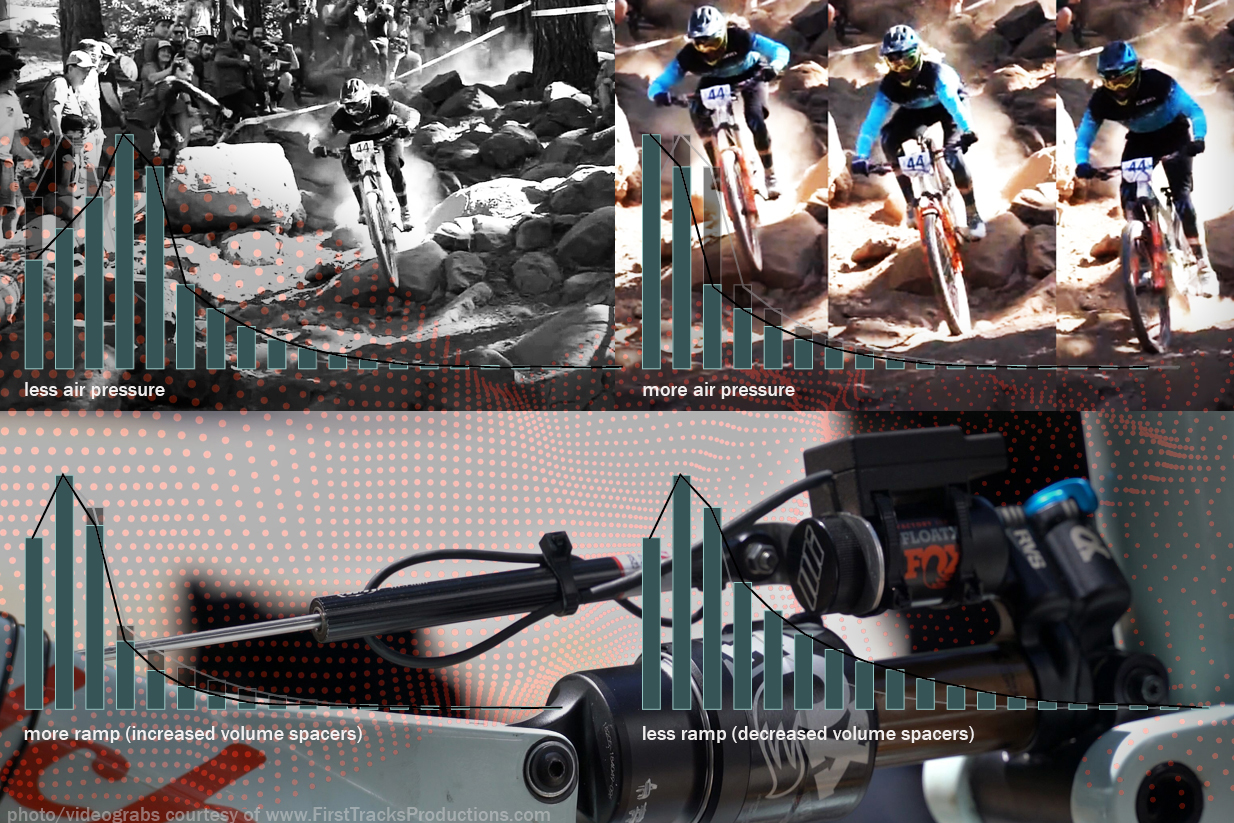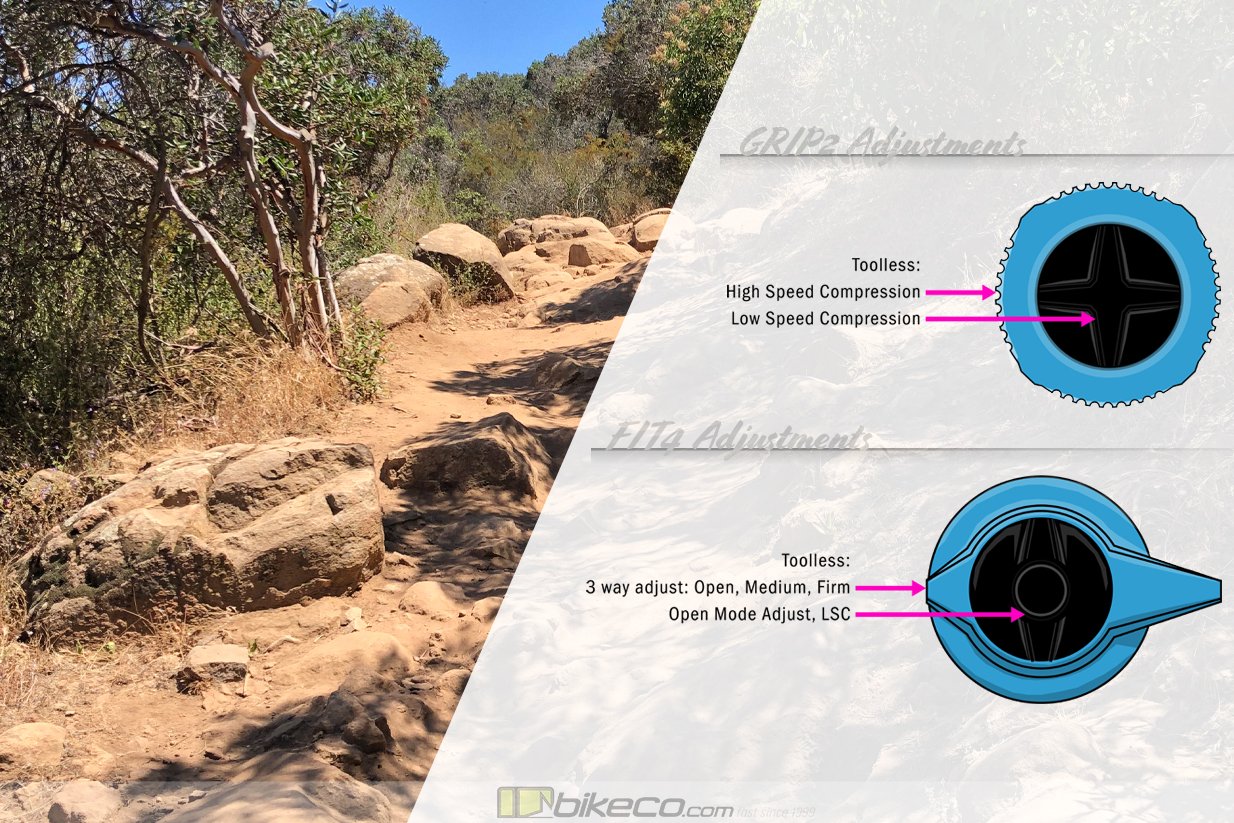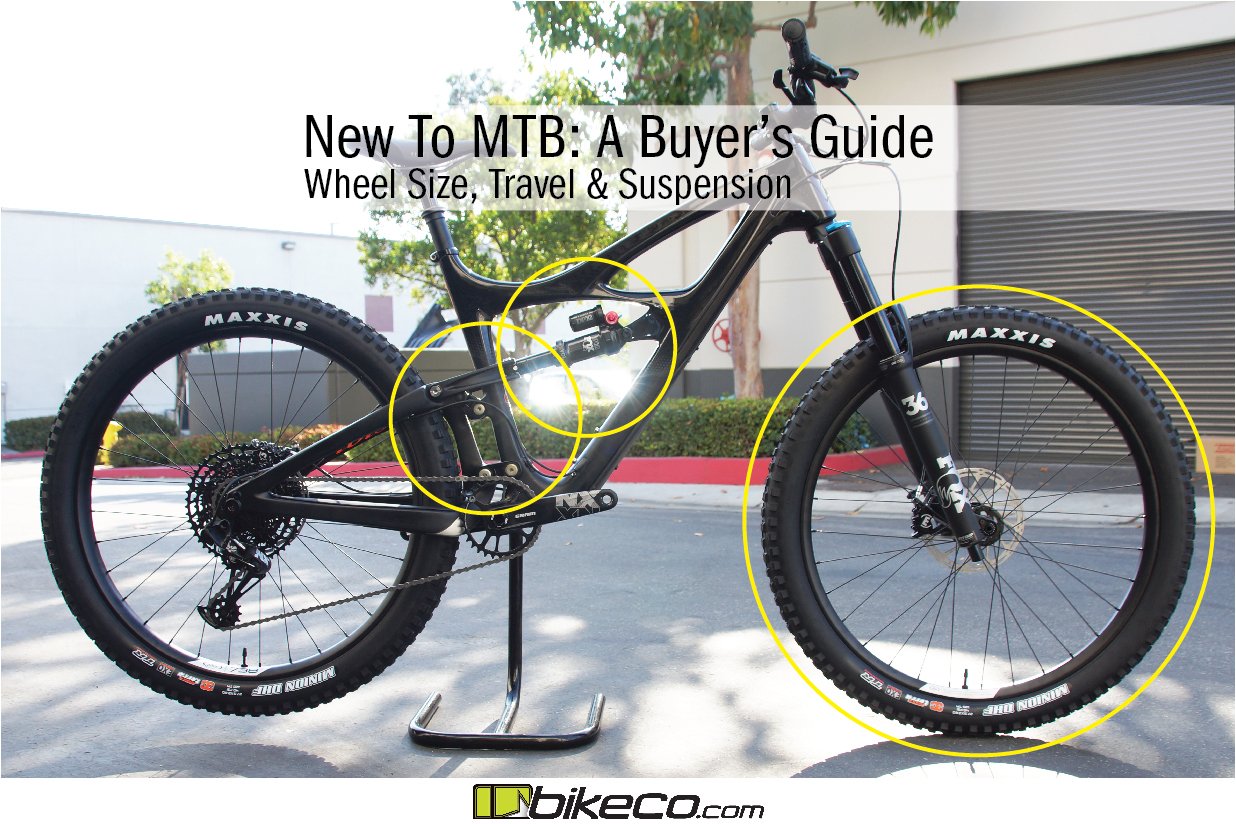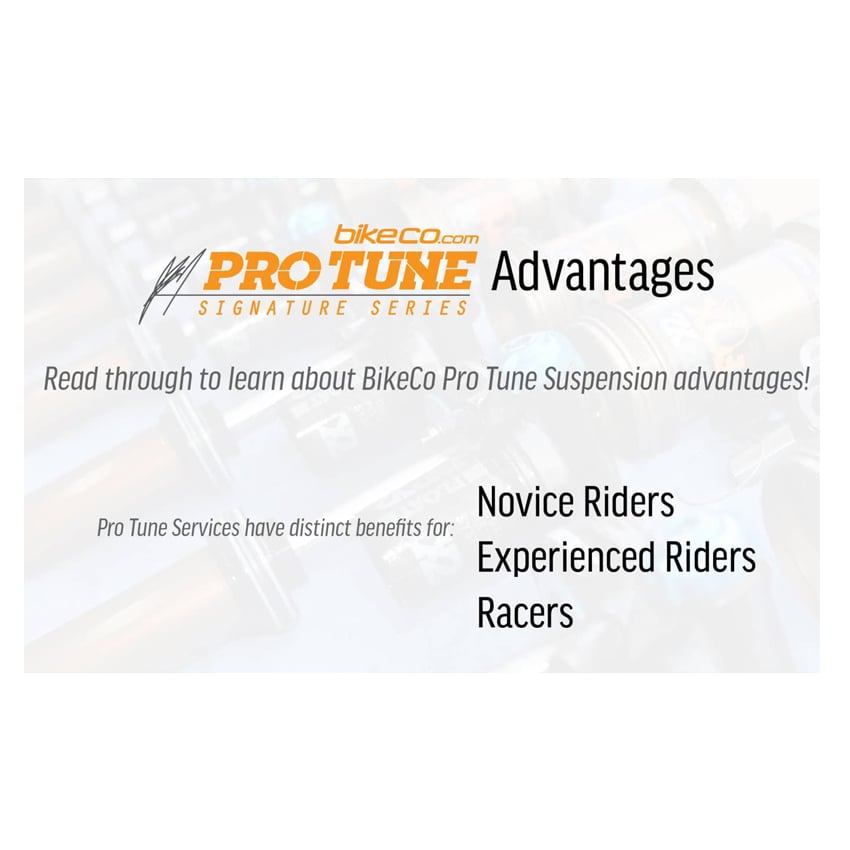
Check out this video to learn more about BikeCo Pro Tune Suspension for FOX forks and FOX shocks from Pro-Rider Cody Kelley and BikeCo’s Joe Binatena!
Keep reading for more details on BikeCo’s proprietary FOX suspension tuning.
BikeCo Pro Tune Suspension Advantages
For years we’ve has been providing riders access to the best performing Fox Suspension through our proprietary Pro Tunes designed by BikeCo.com owner Joe Binatena.
BikeCo Pro Tune Suspension is designed to maximize damper performance to your riding specifics. Rear shocks are built chassis specific, we don’t offer a Pro Tune shock for every bike, but do for Ibis, Yeti, Mondraker, Specialized, Santa Cruz, Intense, YT, Giant and more.

BikeCo Pro Tune Suspension
There are many aspects to BikeCo.com that separate us from the competition. One cornerstone the competition simply can’t imitate is our BikeCo Pro Tune Suspension. Available on FOX forks and rear shocks these individual tunes narrow the adjustment window from the stock “works for everyone” to a more finite setup based on your size, riding style, bike, terrain, speed and aspirations.
BikeCo Pro Tune Suspension
There are many aspects to BikeCo.com that separate us from the competition. One cornerstone the competition simply can’t imitate is our BikeCo Pro Tune Suspension. Available on FOX forks and rear shocks these individual tunes narrow the adjustment window from the stock “works for everyone” to a more finite setup based on your size, riding style, bike, terrain, speed and aspirations.
Pro Tune Suspension: What’s Changed?
BikeCo Pro Tuned Forks
Well, without giving out all the ingredients to the secrets we can look at some aspects that help BikeCo Pro Tune Suspension outperform the stock setups.
The fork’s upper and lower mechanical fit is improved on Pro Tune Forks. Reducing the slide friction between the stanchions and fork lowers helps minimize sticktion in both compression and rebound for better bump compliance and damper setup.
Proprietary lubes based on rider details provide better internal oiling while accounting for heat generated by ground speeds and terrain.
Another major aspect of BikeCo Pro Tune Suspension is the improved damper bleeds. After many years working on a wide range of suspension with the fastest racers in MTB our team has developed bleed techniques, tools and lube additives. Eliminating air trapped in the dampers as well as off-gas of settling hydraulic fluid takes longer and involves additional tooling – but the results are well worth it!
The last aspect of BikeCo Pro Tuned Forks we’ll get into (like I said, can’t give you all the secrets) is the support from our team. Everyone on-staff rides. All of us are familiar with suspension setup advantages and disadvantages. And we all have access to the suspension tuners if there’s a question over our heads. As your riding advances adjustments to the PSI, rebound, compression and volume spacing will help continue to fine tune the bike. Our team is here to help you better understand all of those adjustments and how they work together.
BikeCo Rear Shock Pro Tunes
Like our fork services BikeCo Rear Shock Pro Tunes utilize proprietary lubes and additive packages. These are designed to improve the shock’s consistency during heat variations.
Also, like Pro Tune Forks, our rear shock damper bleeds are more precise which improves the damper’s consistency. Any air that cavitates a hydraulic system compromises the fluid flow by producing a compressible pocket as well as having different heat properties from the hydraulic fluid – ie – that cool air bubble is going to behave differently mid-way down the hill as it heats up and increases in PSI pushing against the fluid on both sides.
Improving how the compression and rebound dampers behave allow us a wider range of rider setup options in PSI and volume spacing.
Again, FOX makes a great “works for everyone” product, but chances are your bike’s not being ridden by a 145lb who’s tip toe-ing across the trail and a 300lb rider smashing through every bit of chunk they can find. So, if you have the opportunity to fine tune your suspension for your specifics it makes a lot of sense to right?
Our team’s expertise balancing air pressure, volume spacing, compression as well as rebound settings goes a long way in dialing in a bike’s performance.
Things You Won’t Find in Pro Tune Suspension
If you do something well, for any length of time, you’ll see some imitation. Well with the years of expertise you can see how far along their own journey some of the other tuners are. You can also see how far out in the weeds some are!
Highlights of things you won’t see our team do: there was a fork years ago that had basically a fast food straw and some zip ties trying to extend the fluid volume between ports. That one, well, ya. Wow. Another more recent rear shock came in after another tuner worked on it. Upon disassembly there were a handful of bent shims. Rather than designing a shim stack to achieve the goals these were simply “lighter” shims I assume to improve bump compliance. Well, the stack bent and that was that for basically any damping control. But, the shims were oil slick color – so that counts right? No? Ya, I didn’t think so…
What You Feel with Pro Tune Suspension
Alright, you hung in through the description of the non-secret ingredients. But what will you actually feel on trail with Pro Tune Forks and Rear Shocks?
If I tell you you’d have a more plush feel with better support you’d say that’s what every suspension ad for ten years has promised right? Well, BikeCo Pro Tune Suspension has the individualized balance to make that happen.
First, let’s look at something that has created more than a little bit of confusion over the years. The difference between what you and I likely mean when we say “small bump compliance” and what a lot of the engineers in the industry mean.
If you’re like us, when you think of small bump compliance you’re picturing the trail chatter that begins to compress your suspension past the point of sag. Makes sense right? Like the sag point would be your “zero” and the beginning of travel past that would be the “small bumps”?
Most suspension designers disagree. That’s why your last four forks all with “improved small bump compliance” feel similar. Generally they are assigning the “small bump compliance” area of travel to the section between full extension and sag.
The way these designers have marketed improved small bump compliance is by utilizing more aggressive ramp rates through volume or compression settings. So the suspension IS “lighter” until it has to pick your weight up. And then, from there, it’s going to frankly be harsher. Which, is the “more support in the mid-stroke”.
We see it a little different.
When our team is chatting with clients we reference Small Bump Compliance as the area of initial compression past the point of sag. We feel that this is what clients are referring to when they tell us about small bump issues and we agree.
Understanding that riders want support to minimize brake dive as well as to provide additional support in fast corners without creating hand numbing abuse over the small stuff has driven our tune philosophy.
Narrowing the rebound and compression damper’s performance window also gives each click a more finite adjustment window. This makes your suspension more precise and easier to tune to your ideals.
Improving the fork’s upper and lower fitment eliminates a good deal of sticktion allowing riders to run a higher main PSI which improves support while minimizing brake dive. A softer feeling fork at a higher PSI.
Improving the compression circuits also allows more finite tuning with both the hydraulic dampers as well as volume tuning options to change ramp rate. Pro Tune riders tend to find they are able to run more clicks of compression in order to dial in mid and end stroke support without losing suppleness and traction.
Once again coming back to the support from our team – our staff is trained to help you define how tire sidewalls, rim width and volume, rim protection options, tire PSI, brake setup and other attributes will critically effect your suspension’s performance.
Are Pro Tunes only for Racers?
Absolutely not! This is one of the compromises of naming something I suppose. But BikeCo Pro Tune Services might have even more impact for less experienced riders.
That’s because with suspension designed to work in a more finite window as well as having access to our team to help you tune and adjust the tune as your riding improves you can concentrate on riding techniques, reading terrain and worry less about the myriad of adjustments required to dial in your bike.
Read more about BikeCo Pro Tunes below!
Pro Tune Design Factors
Pro Tune’s shift performance windows taking into account CHASSIS, RIDER SIZE, EXPERIENCE, DISCIPLINE, TERRAIN, STYLE as well as RIDING GOALS.
Rider Size:
Different size different setups, easy right? Stock suspension is designed for a wide range or riders. Suspension is significantly over compressed for even average size riders “out of the box”.
As a result Pro Tune suspension is an eye opener for lighter riders. Compression controls are shifted to be effective. One click of low speed compression is no longer the equivalent of a lock out!
Experience:
As your riding progresses your suspension needs change. A pro racer will pump hard into a hole in a steep chute to keep the bike at maximum speed, while an advanced rider may pull up or air over it, and a more novice rider may plow into it altogether on the brakes. These all require different tunes and setups.
Discipline:
BikeCo Pro Tune Suspension covers riders from cross country, trail, endure, park to downhill. Each style has unique requirements and cross over points. Ramp rates and compression settings are particularly important. An XC racer may not want to sacrifice a firm lockout while an Enduro racer could utilize a lockout more as a “trail” compression setting.
Terrain:
Type and size of terrain that a rider is comfortable in make a difference in final setup. Riders in flatter terrain appreciate more “pop” in their setup. On the contrary the same level of “pop” maybe disconcerting to a rider blasting chunky chutes as they bounce down trail!
Style:
Are you a basher? Smooth as silk? Somewhere in the middle? Pro Tunes have you covered across the board. Even riders in the same terrain, with similar ground speeds as well as size may have quite varied setups based on style. Personally I have tried to rider smoother as I’ve aged. Even being heavier than our racers I prefer a lighter compression tune since I’m not longer smashing into holes at full speed!
Riding Goals:
Where are you going with your riding? Working hard to improve skillset? Let’s get a tune setup to ensure it takes you where you plan to go. Racing? Improving speed? More confidence? Of course we’ve got you covered.
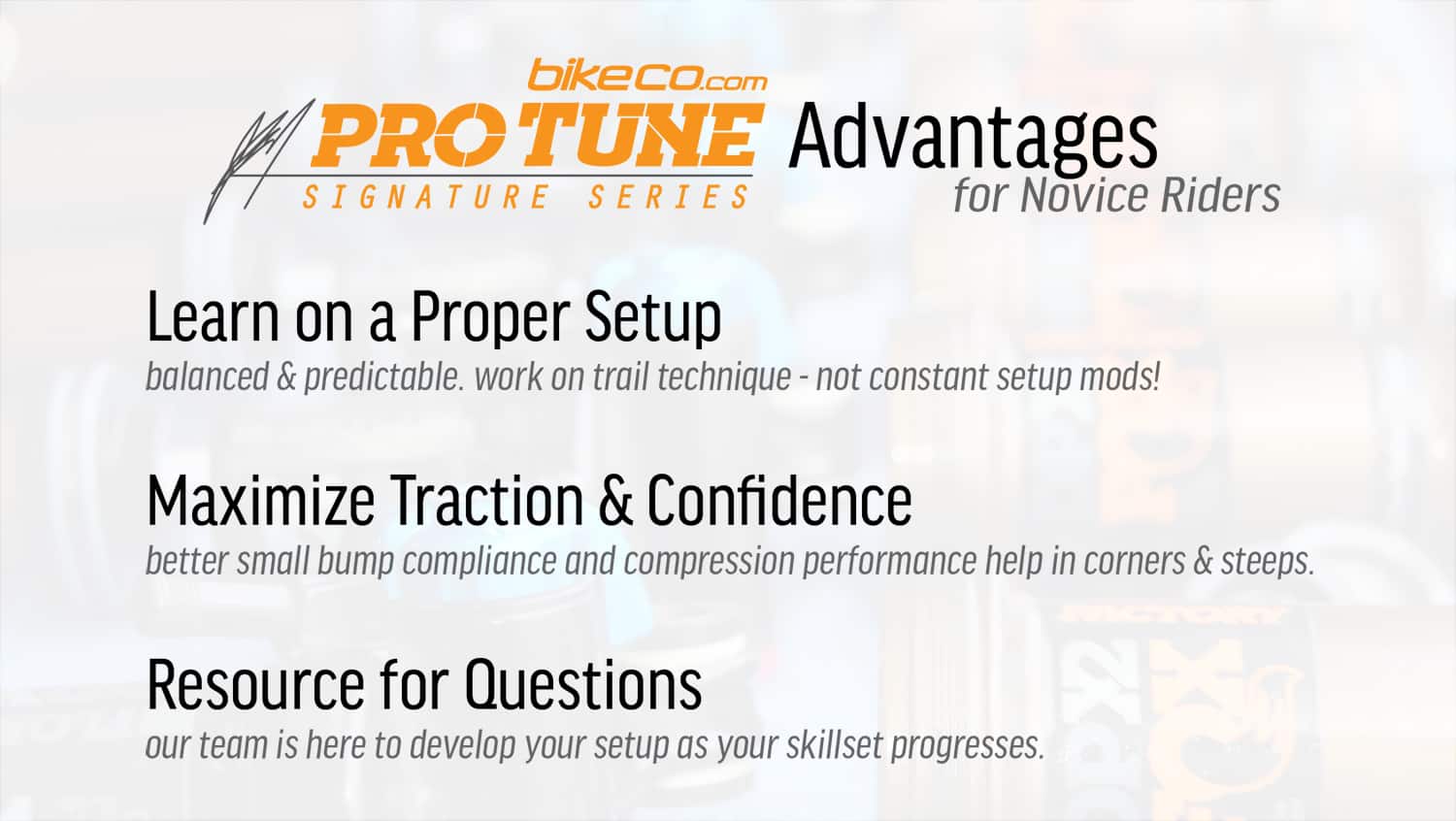
Rider Goals for Tuned MTB and eMTB Suspension
Common Tune Goals CONFIDENCE, PREDICTABILITY, TUNE-ABILITY
Confidence:
Pushing your riding to the next level is always easier when you’re confident in your equipment. Confident riders concentrate on riding technique as well as improved trail vision.
Better small bump compliance, traction, and support from Pro Tune Suspension improve confidence.
Predictability:
Tied in with confidence, the more predictable your suspension is the less you’re concentrated on components and the more you’re trail aware.
Proprietary oil blends as well as personally tuned oil flow rates produce suspension much less susceptible to heat (or cold) temperature saturation or issue.
Tune-Ability:
Pro Tune suspension shifts performance bands to maximize external control availability. Particularly high and low speed compression controls become more useful.
Light rider? BikeCo Pro Tune’s are designed to allow lighter riders to fine tune additional support through compression without creating an overly harsh platform.
Going to the bike park? In this situation add a click or two of low speed compression to support the front end through high speed berms or steeper chutes.

Some Pro Tune Modifications
Some of the modifications for suspension improvement include FITMENT, OIL FLOW / PERFORMANCE and VOLUME SPACING.
Fitment:
Aligning the upper and lower fork legs drastically minimizes sticktion. Less sticktion without a doubt means better small bump compliance.
Oil Flow / Performance:
Pro Tune suspension uses a variety of proprietary oil blends to maximize additive packages depending on use. Rider size, ground speed and aggressiveness are reviewed to determine the best oil package as well as modifications required to adjust the ideal flow rate.
Minimizing the stress on the oil improves its service life expectancy. Less stressed oil is less apt to create performance issues due to temperature.
Volume Spacing:
Changing the characteristics of air spring performance effects ramp rate, travel usage as well as PSI at sag. Different leverage ratio suspensions require different ramp characteristics.
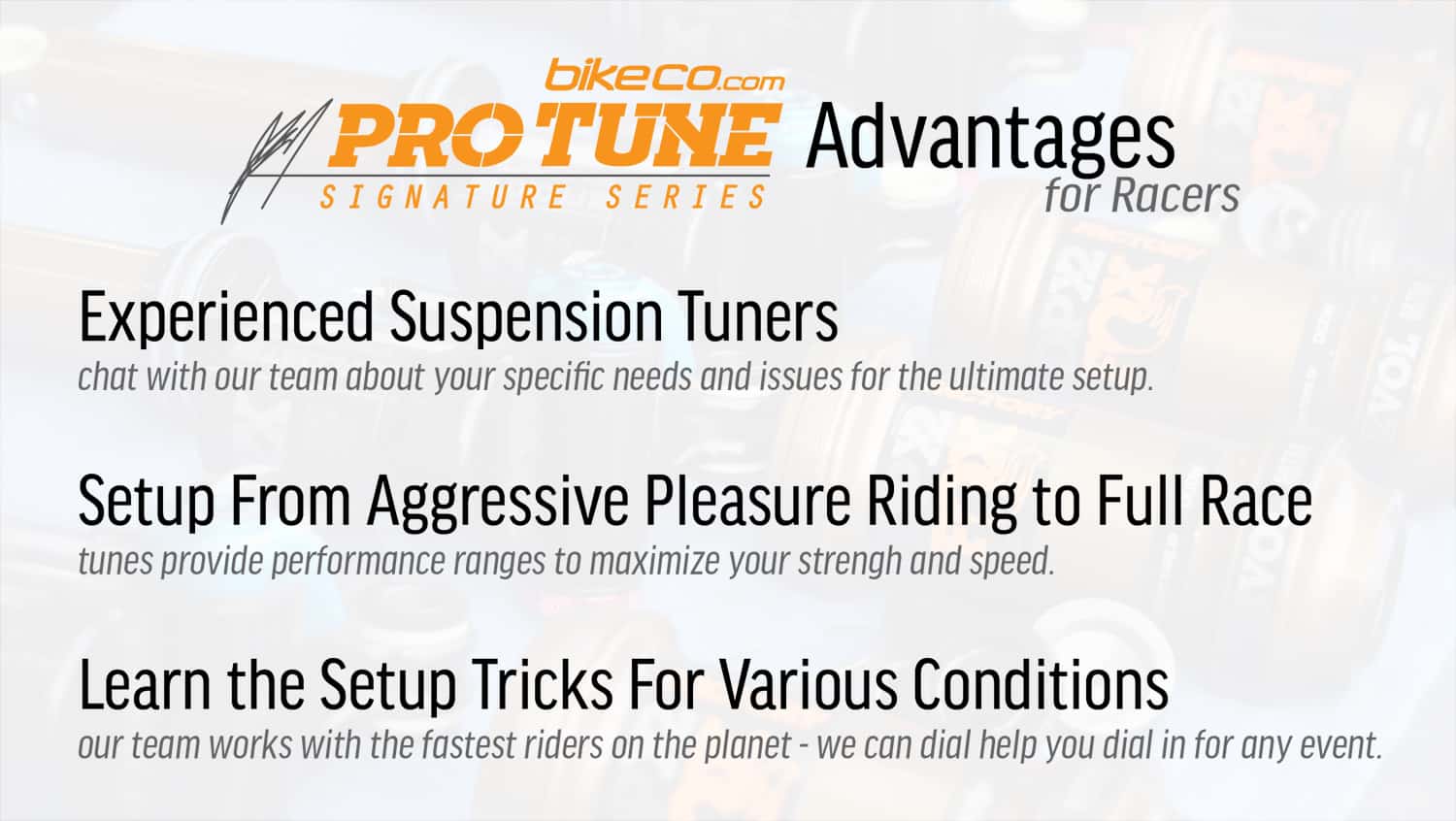
Notable Improvements with BikeCo Pro Tune
What are some of the most notable improvements? Let’s glance at SMALL BUMP COMPLIANCE, RAMP RATE, HEAT SATURATION and SUPPORT x 2.
Small Bump Compliance:
Better small bump compliance equals improved traction. Most stock dampers are over compressed. Improving the oil flow characteristics, fitment, as well as sag PSI allow maximum traction through small bump compliance.
Critical in cornering, braking and holding lines traction gains are notable from the beginner to expert rider. The difference between the beginner and expert rider’s ground speed means that the setup as well as tune will be different to balance a comfort level on traction and ground speed.
Ramp Rate:
Tuning ramp rate to a particular suspension system’s leverage ratio and rider size allows a more predictable trail feel through the travel.
Using too much or too little travel? In that case along with compression controls ramp rate is available to fine tune air spring progression through volume spacing.
Heat Saturation:
Changes in oil temperature notable effect damper performance. A shock may start a downhill run feeling plush but at the bottom may be so harsh a rider has a hard time holding onto the bars.
Improving the flow for specific riders means BikeCo Pro Tune Suspension doesn’t over stress oil properties. Controlling the oil flow through additive package blends, shim stacks, etc balancing rider size, speed and aggression are critical to Pro Tune performance.
Support:
Pro Tune suspension is designed to maximize small bump compliance without compromising air spring pressure or sag percentage. This provides a more supportive platform, particularly under braking, reducing dive. Modifications to the system also improve low speed compression controls allowing riders to fine tune performance on trail. Dropping into your favorite steep trail? Add a click or two of low speed compression to keep your bike riding taller in the travel. Feel like the bike is a bit low in high speed berms? Same thing. A click or two of compression will help stand the bike up without sacrificing too much small bump compliance.
Support x 2:
To get the most out of your Pro Tune Suspension with BikeCo’s team. Staff will reach out to each rider assessing on trail performance and setup needs. Our expert team will explain the basics of your setup along with common tricks to dial in your bike. A series of phone calls after pickup allows our team to get inside your head on trail to make finite adjustments as required.
Warranty:
Pro Tune Suspension offers disposition re-tunes for 30 days. (example, from time to time we have riders who are much faster than they let on and require a more aggressive tune). We stand behind all suspension service for 90 days.
Ready to go? Have additional questions? Reach out to our staff today by phone, email or chat. Check out other BikeCo Service Rates Here





